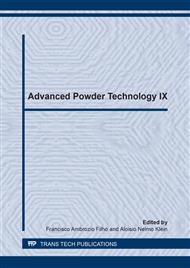p.135
p.140
p.146
p.152
p.158
p.163
p.168
p.174
p.180
Investigation of Boron Doped Nanocrystalline Diamond Films Grown on Porous Silicon Substrate under Different Doping Concentrations
Abstract:
The production and characterization of porous silicon (PS) samples were studied as well as their use as substrates to grow boron doped nanocrystalline diamond (NCD) films. PS represents a suitable material for diamond growth due to its large number of nucleation sites and surface area, becoming an excellent material for porous electrodes. NCD films were grown by chemical vapor deposition (CVD) technique by balancing H2/CH4/Ar gas mixture, at two different boron levels. Doping was conducted by an additional hydrogen line passing through a bubbler containing B2O3 dissolved in methanol. Two ratios of boron/carbon were used of 2000 and 20000 ppm in the bubbler solution. Scanning electron microscopy, Raman spectroscopy and X-ray diffraction were used to characterize the films as well as the PS substrate. Results showed that it is possible to obtain NCD films on PS substrate with good quality at different doping levels.
Info:
Periodical:
Pages:
158-162
Citation:
Online since:
December 2014
Price:
Сopyright:
© 2014 Trans Tech Publications Ltd. All Rights Reserved
Share:
Citation:


